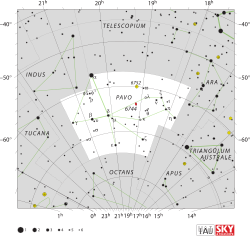Delta Pavonis
| Observation data Epoch J2000 Equinox J2000 |
|
|---|---|
| Constellation | Pavo |
| Right ascension | 20h 08m 43.60953s |
| Declination | −66° 10′ 55.4436″ |
| Apparent magnitude (V) | 3.56 |
| Characteristics | |
| Spectral type | G8 IV |
| U−B color index | 0.45 |
| B−V color index | 0.76 |
| Variable type | Suspected |
| Astrometry | |
| Radial velocity (Rv) | −21.7±0.9 km/s |
| Proper motion (μ) |
RA: +1,211.03 mas/yr Dec.: –1,130.05 mas/yr |
| Parallax (π) | 163.71 ± 0.17mas |
| Distance | 19.92 ± 0.02 ly (6.108 ± 0.006 pc) |
| Absolute magnitude (MV) | 4.62 |
| Details | |
| Mass | 0.991 M☉ |
| Radius | 1.22 R☉ |
| Luminosity | 1.22 ± 0.04 L☉ |
| Surface gravity (log g) | 4.26 cgs |
| Temperature | 5,604 K |
| Metallicity [Fe/H] | +0.33 dex |
| Rotational velocity (v sin i) | 1.0 km/s |
| Age | 6.6–6.9 Gyr 9.3 Gyr |
| Other designations | |
| Database references | |
| SIMBAD | data |
Delta Pavonis (δ Pav, δ Pavonis) is a star in the southern circumpolar constellation of Pavo. It has an apparent visual magnitude of 3.56, making it a fourth-magnitude star that is visible to the naked eye from the southern hemisphere. Parallax measurements from the Hipparcos satellite yield an estimated distance of 19.92 light-years (6.11 parsecs) from Earth. This makes it one of the nearest bright stars to the Solar System.
It is a subgiant of spectral type G8 IV, meaning it is about to stop fusing hydrogen in its core and is starting the process of becoming a red giant. Because of that, Delta Pavonis is 22% brighter than the Sun even though the effective temperature of its outer atmosphere is lower, at 5,604 K. It has 99.1% of the Sun's mass and 122% of the Sun's radius. The surface convection zone extends downward to about 43.1% of the star's radius, but only contains 4.8% of the star's mass.
Spectroscopic examination of this star shows that it has a higher abundance of elements heavier than helium (or metallicity, as astronomers call it) than does the Sun. This value is typically given in terms of the relative ratio of iron (chemical symbol Fe) to hydrogen (H) as compared to the Sun's atmosphere (iron being a relatively easy element to detect in a stellar atmosphere). For Delta Pavonis, the metallicity is about:
...
Wikipedia

